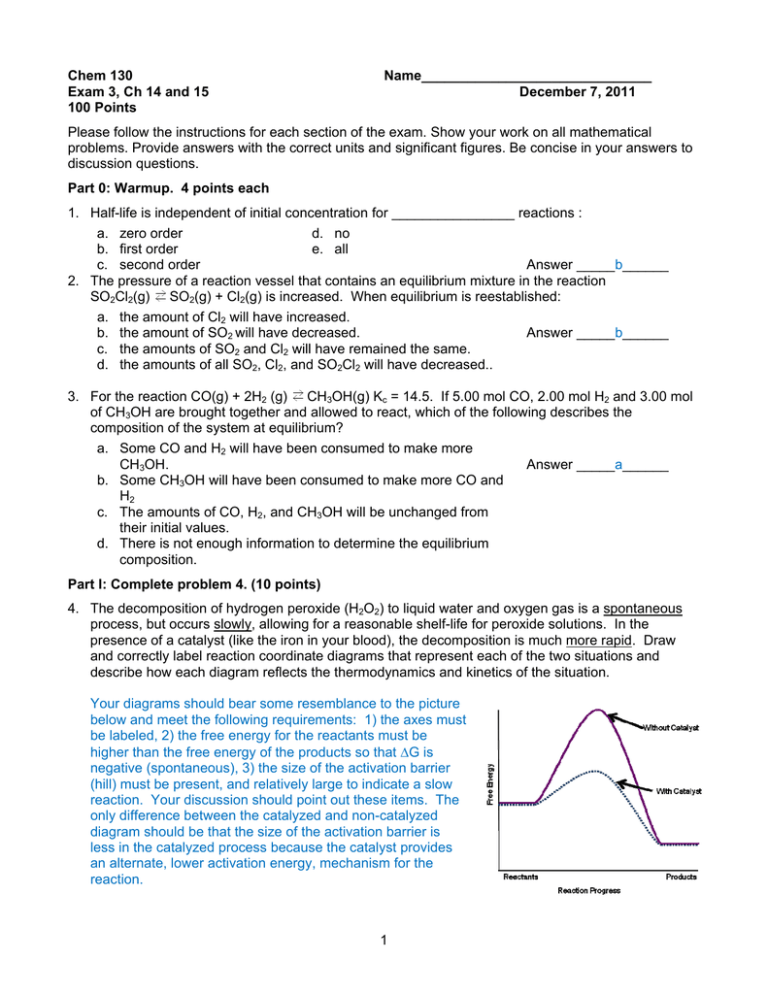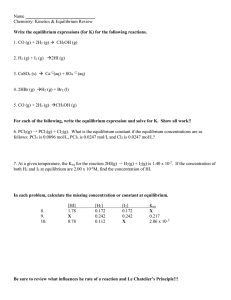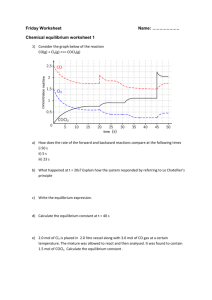Please follow the instructions for each section of the exam.... problems. Provide answers with the correct units and significant figures.... Chem 130
advertisement

Chem 130 Exam 3, Ch 14 and 15 100 Points Name______________________________ December 7, 2011 Please follow the instructions for each section of the exam. Show your work on all mathematical problems. Provide answers with the correct units and significant figures. Be concise in your answers to discussion questions. Part 0: Warmup. 4 points each 1. Half-life is independent of initial concentration for ________________ reactions : a. zero order d. no b. first order e. all c. second order Answer _____b______ 2. The pressure of a reaction vessel that contains an equilibrium mixture in the reaction SO2Cl2(g) SO2(g) + Cl2(g) is increased. When equilibrium is reestablished: a. the amount of Cl2 will have increased. Answer _____b______ b. the amount of SO2 will have decreased. c. the amounts of SO2 and Cl2 will have remained the same. d. the amounts of all SO2, Cl2, and SO2Cl2 will have decreased.. 3. For the reaction CO(g) + 2H2 (g) CH3OH(g) Kc = 14.5. If 5.00 mol CO, 2.00 mol H2 and 3.00 mol of CH3OH are brought together and allowed to react, which of the following describes the composition of the system at equilibrium? a. Some CO and H2 will have been consumed to make more Answer _____a______ CH3OH. b. Some CH3OH will have been consumed to make more CO and H2 c. The amounts of CO, H2, and CH3OH will be unchanged from their initial values. d. There is not enough information to determine the equilibrium composition. Part I: Complete problem 4. (10 points) 4. The decomposition of hydrogen peroxide (H2O2) to liquid water and oxygen gas is a spontaneous process, but occurs slowly, allowing for a reasonable shelf-life for peroxide solutions. In the presence of a catalyst (like the iron in your blood), the decomposition is much more rapid. Draw and correctly label reaction coordinate diagrams that represent each of the two situations and describe how each diagram reflects the thermodynamics and kinetics of the situation. Your diagrams should bear some resemblance to the picture below and meet the following requirements: 1) the axes must be labeled, 2) the free energy for the reactants must be higher than the free energy of the products so that G is negative (spontaneous), 3) the size of the activation barrier (hill) must be present, and relatively large to indicate a slow reaction. Your discussion should point out these items. The only difference between the catalyzed and non-catalyzed diagram should be that the size of the activation barrier is less in the catalyzed process because the catalyst provides an alternate, lower activation energy, mechanism for the reaction. 1 Part II Kinetics. Answer three (3) of problems 5-8. Clearly mark the problems you do not want graded. 15 points each. (13 points each) Use the tabulated data below for problems 5 and 6. The data corresponds to the reaction below and shows dependence of concentration of A on time in experiments run at three temperatures. 2A B + C Time (sec) 0 1 2 8 32 T = 298 K [A] (M) 0.1000 0.0999 0.0999 0.0995 0.0980 T = 348 K [A] (M) 0.1000 0.0991 0.0983 0.0932 0.0755 T = 398 K [A] (M) 0.1000 0.0940 0.0883 0.0609 0.0137 5. Consider the data above. Clearly describe how the data could be used to determine the order for the reaction in A. No calculations are necessary. Feel free to include appropriate diagrams. For a single dataset collected at any temperature, calculate ln[A] and 1/[A]. Generate three y vs x plots; [A] vs time, ln[A] vs time, 1/[A] vs time and examine each plot to check for linearity. If the [A] vs time plot is linear, the reaction is zero order in A. If the ln[A] vs time plot is linear, the reaction is first order in A. If the 1/[A] vs time plot is linear, the reaction is second order in A 6. Consider the data above. Assuming you know the reaction to be first order in A, describe how you could determine the activation energy for the reaction. No calculations are necessary. Feel free to include appropriate diagrams. We need to determine how the rate constant changes with time. In order to do so, we need the value for the rate constant at each temperature. To get this value, plot ln[A] versus time for each temperature. Since the reaction is first order, each plot should be linear and the slope of each line is –k for that temperature. Once we have determined k’s we can take advantage of the relationship: E 1 ln k a ln A . R T If we plot ln k versus 1/T we should get a straight line with a slope of –(Ea/R). Since R is constant, we can calculate Ea. NOTE: You could also use the relationship: ln k 2 Ea 1 1 k1 R T1 T2 . You still need the rate constants for two temperatures before you can solve this for Ea. 2 7. The reaction I-(aq) + OCl-(aq) IO-(aq) + Cl-(aq) was studied and the data below were obtained. Determine the rate law and the value of the rate constant for this reaction. [I-]0(mol/L) 0.12 0.060 0.030 0.24 [OCl-]0(mol/L) 0.18 0.18 0.090 0.090 Initial Rate (mol/Ls) 0.0791 0.0395 0.00988 0.0791 Rate1 = k[I-]x[OCl-]y = 2 = k[0.12]x[0.18]y = 2x x = 1 Rate2 k[I-]x[OCl-]y k[0.06]x[0.18]y Rate2 = k[I-]x[OCl-]y = 4 = k[0.06]1[0.18]y Rate3 k[I-]x[OCl-]y k[0.03]1[0.09]y 2 = [0.18]y [0.09]y Rate = k[I-][OCl-] k = y=1 Rate = 0.0791 mol/Ls = 3.66 L or 3.66 M-1s-1 [I ][OCl ] (0.12 mol/L)(0.18 mol/L) mol s - 8. Experiment has shown that the rate law for the reaction 2NO(g) + Cl2(g) 2NOCl(g) is Rate = k[NO][Cl2]. One proposed mechanism for this process is shown below, with the second step being rate-determining. Is this a reasonable mechanism for the reaction? Justify your decision. k1 NO + Cl2 NOCl2 (fast) k-1 k2 NOCl2 + NO 2NOCl (slow) Your first step would be to check that the stoichiometry for the sum of the elementary steps matches that for the overall reaction. In this case, it does. Then, determinine the rate law for this mechanism, starting with the rate law for the slow step. Rate = k2[NOCl2][NO] Since NOCl2 is an intermediate, we need to find an expression for it in terms of reactants. Because step 1 is an equilibrium, the rate of the forward and reverse reactions are equal k1[NO][Cl2] = k-1[NOCl2] Solving for [NOCl]2: (k1[NO][Cl2])k-1 = [NOCl2] Inserting this into the original rate law gives us Rate = k2 (k1[NO][Cl2])k-1 [NO] Rate = k[NO]2[Cl2] This does not match the experimental rate law, indicating that the mechanism is not reasonable, assuming the experimentally-determined rate law is valid. 3 Part III Equilibrium. Answer three (3) of problems 9-12. Clearly mark the problems you do not want graded. (13 points each) 9. What do we mean when we say a system has come to equilibrium? Describe the equilibrium condition and why we don’t use a single headed arrow when we write equilibria. What does a small equilibrium constant mean in terms of thermodynamics? At equilibrium, the rate of the forward reaction is equal to the rate of the reverse reaction. (Note that this does not mean that the concentrations are equal or that the rate constants are equal!). Both the forward and reverse reactions are still proceeding at equilibrium, only reactants and products are both being consumed at equal rates. As a result, there is no net change in concentrations of reactants or products. At equilibrium, the K expression is satisfied. We use the double-headed arrow to indicate that the reaction is proceeding in both directions. As small equilibrium constant indicates a reaction that is not product favored. The tendency of the reaction is to favor the reactant side. As K decreases, the reaction becomes less spontaneous. 10. Consider the reaction below. If the initial concentrations of H2, F2, and HF are 0.0100M, 1.25 M, and 2.21 M, respectively, is the system at equilibrium? If not, which way will the reaction go to achieve the equilibrium condition? Set up, but do not complete the calculation you would use to determine the equilibrium concentrations of each of the species in the reaction. You DO NOT need to arrive at a numerical answer, just get to the point where you have one algebraic expression you could solve, given additional time. Be sure to tell me what you would do with the result of your calculation. H2(g) + F2(g) 2HF(g) K = 115 Since we have intital concentrations of all species, we need to calculate Q first to determine the direction the reaction must go to get to equilibrium. [HF]2 = (2.21 M)2 = 390 [H2][F2] (0.0100 M)(1.25 M) Since Q>K, the reaction is product heavy and more reactants will be formed on the way to equilibrium. H2 + F2 2 HF i 0.0100 M 1.25 M 2.21 M c +x +x -2x e 0.0100 + x 1.25 +x 2.21 – 2x Q = Insert these values into the equilibrium constant expression: K = [HF]2 = = 115 (2.21 - 2x)2 [H2][F2] (0.0100 + x)(1.25 + x) The boldface expression can now be solved for x, giving two possible solutions (quadratic). After choosing the chemically sensible solution, equilibrium concentrations can be calculate: [HF] = (2.21 – 2x)M, [H2] = (0.0100 + x)M, [F2] = (1.25 + x)M 4 11. Suppose the reaction system below has already reached equilibrium. Predict the effect of the following changes on the system. Justify your predictions with a brief statement. UF4(g) + 2H2O(g) UO2(s) + 4HF(g) a. More UO2 is added to the system. Since UO2 is a solid, it does not show up in the equilibrium constant expression, so its addition will have no impact on the position of the equilibrium. b. The reaction is performed in a glass reaction vessel and the HF reacts with the glass. HF, a reactant is being consumed; therefore the equilibrium will shift to the left to generate additional reactant. c. Water vapor is removed. H2O, a product is being consumed; therefore the equilibrium will shift to the right to generate additional product. d. The volume is increased. An increase in volume would lead to a decrease in pressure, which will cause the equilibrium to shift in the direction of the most molecules of gas, in this case, to the left. 12. You have been tasked with determining the equilibrium constant for the reaction of H2 and S2 gases to produce hydrogen sulfide. A mixture of 1.00 g H2 and 1.00 g H2S in a 0.500 L flask comes to equilibrium at 1670 K. At equilibrium, there is 8.00 x 10-6 mol of S2 present. What are the values for Kc and Kp at this temperature? Start with a balanced chemical reaction: 2H2 + S2 2H2S So, the equilibrium constant expression (Kc) is: Kc = [H2S]2 [H2]2[S2] We need equilibrium concentrations of each species to find the Kc. We start buy determining initial concentrations: 1.00 g H2 x 1 mol x 1 = 0.9921 M H2 2.01588 g 0.500 L 1.00 g H2S x 1 mol x 1 = 0.05869 M H2S 34.01819 g 0.500 L The equilibrium concentration of S2 = (8.00x10-6 mol)/0.5 L = 1.60 x 10-5 M S2 Mapping out the chemistry: 2H2 + S2 i 0.9921 M 0 c +2x +x e 0.9921 + 2(1.60 x 10-5) = 1.60 x 10-5 M 0.9922 M Plugging in to Kc: Kc = 2 H2S 0.05869 M -2x 0.05869 – 2(1.60 x 10-5) = 0.05865 M [H2S]2 = (0.05865)2 = 218 [H2]2[S2] (0.9922)2(1.60 x 10-5) Kp = Kc(RT)Dn = 218(0.08206x1670)-1 = 1.59 5 Possibly Useful Information slope m y y 2 y 1 x x 2 x 1 x b b 2 4ac 2a R = 0.08206 L atm mol-1 K-1 R = 8.314 J mol-1 K-1 Kp = Kc(RT)n pV = nRT G = -RTlnK k Ae E a / RT E 1 ln k a ln A R T rate = k[A]1 [A]t = -kt + [A]0 t1/2 = [A]0/2k rate = k[A]2 lnA t kt lnA 0 t1/2 = 1/(k[A]0) rate = k[A]0 1 1 kt A t A 0 t1/2 = 0.693/k 6 ln k 2 Ea k1 R 1 1 T1 T2





